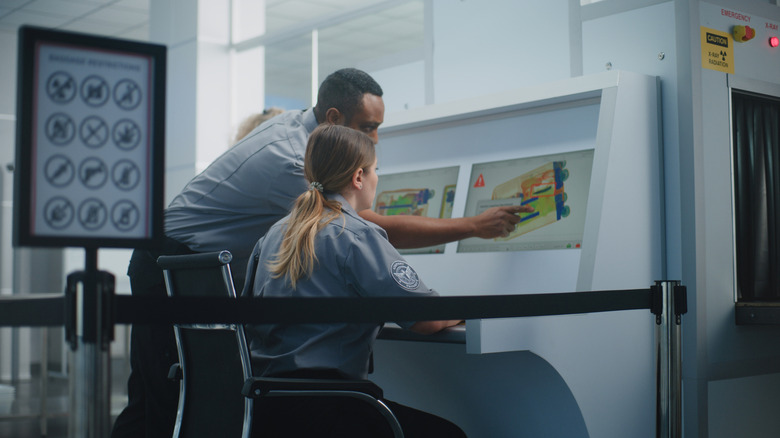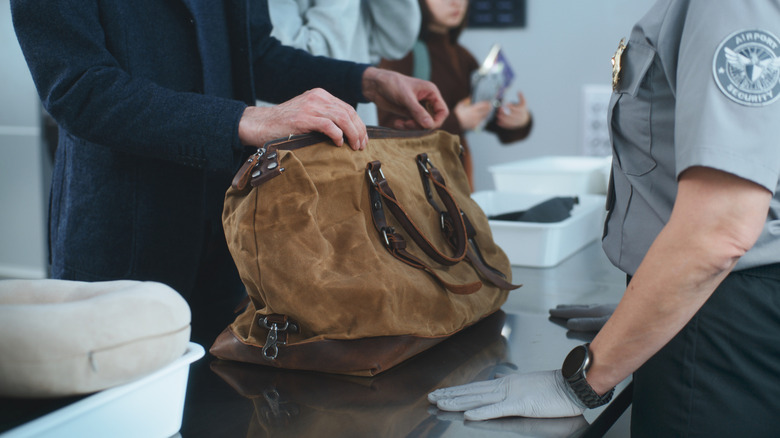The Unexpected TSA Check That Happens Before You Even Set Foot In An Airport
You might think security screening starts only when you get to the airport, but that's far from the truth: It actually begins way before your arrival. You might wonder how the Transportation Security Administration (TSA) achieves this. It starts with the TSA gathering your personal details (including full name, date of birth, and gender) from airlines, information you provided when making a reservation. Then, security officials cross-check this information against government watch lists. The key reason for this is to forestall possible threats long before they get close to the boarding gate. This entire process is done under the Secure Flight program. Note, however, that the TSA won't keep your data permanently, as it assures on its website, "Personal data is collected, used, distributed, stored and disposed of according to stringent guidelines."
The TSA ordinarily has 20 integrated layers of security, many of which the public doesn't even realize. The visible ones are just the bag scanners, metal detectors, and the like. But there are some airport security secrets (including Secure Flight) working quietly in the background as an early vetting process. As such, while you're busy daydreaming about getting to that beautiful destination — perhaps one of Prague's enchanting tourist attractions — the TSA's Secure Flight program is already running your info through databases, as they try determining the threat level of each traveler and how thorough everyone's checking may have to be.
How the Secure Flight program affects you as a flier
When TSA's Secure Flight gathers data, it also categorizes travelers based on the perceived level of risk. And this ultimately influences how you're going to be treated by the time you get to the checkpoint. If you're fortunate to be considered low risk, there's a chance you'd qualify for PreCheck, which comes with the benefit of expedited screening — and you wouldn't even have to remove your shoes, belts, laptops, and other carry-on items. But most passengers tend to go through the standard screening. If you have certain red flags or serious suspicions that land you in the "selectee" category, this situation may put you through additional screening and extra-thorough bag checks. Worst case scenario: The "no fly" category, for extreme cases of threat, would mean prohibition from flying at all.
Here's how the Secure Flight program works: The airline you've booked transfers your details — called Secure Flight Passenger Data (SFPD) — to the TSA 72 hours before departure. After assessing everything and noting the best security measure for each passenger, the TSA sends the pre-screening outcome back to the airline. Accordingly, anyone who's flagged as highly suspicious receives an "SSSS" (selectee) designation on their boarding pass, which means they'll undergo additional screening at the airport.
One interesting thing about this program is that it might be able to make the security lines faster, especially for those considered low-risk travelers. Still, just like any system, Secure Flight isn't foolproof, as a review by the Government Accountability Office (GAO) revealed that there may be cases of oversights and false positives/negatives.
What you need to pay attention to as a traveler
Of all the things you need to ensure, carefulness really matters. Make no mistake in your travel information — meaning that your full name, date of birth, and other details match your government-issued ID perfectly. Any discrepancy, such as a typo or a nickname, can result in delays or additional checks. Importantly, if you happen to be part of PreCheck or Global Entry, don't forget to put in your Known Traveler Number when you're booking so that the system can recognize you.
Sometimes, though, people who have common names may be caught in a mix-up regarding watch lists. So, in case you've been mistakenly matched to someone else, you should apply for a redress number through the Traveler Redress Inquiry Program (TRIP), under the U.S. Department of Homeland Security (DHS). This helps to avoid future misidentification and screening issues. It's equally helpful to learn about the TSA's 3-1-1 rule for liquids, including its exceptions, and you should always place essential items like medicine or electronics in your carry-on bag.


